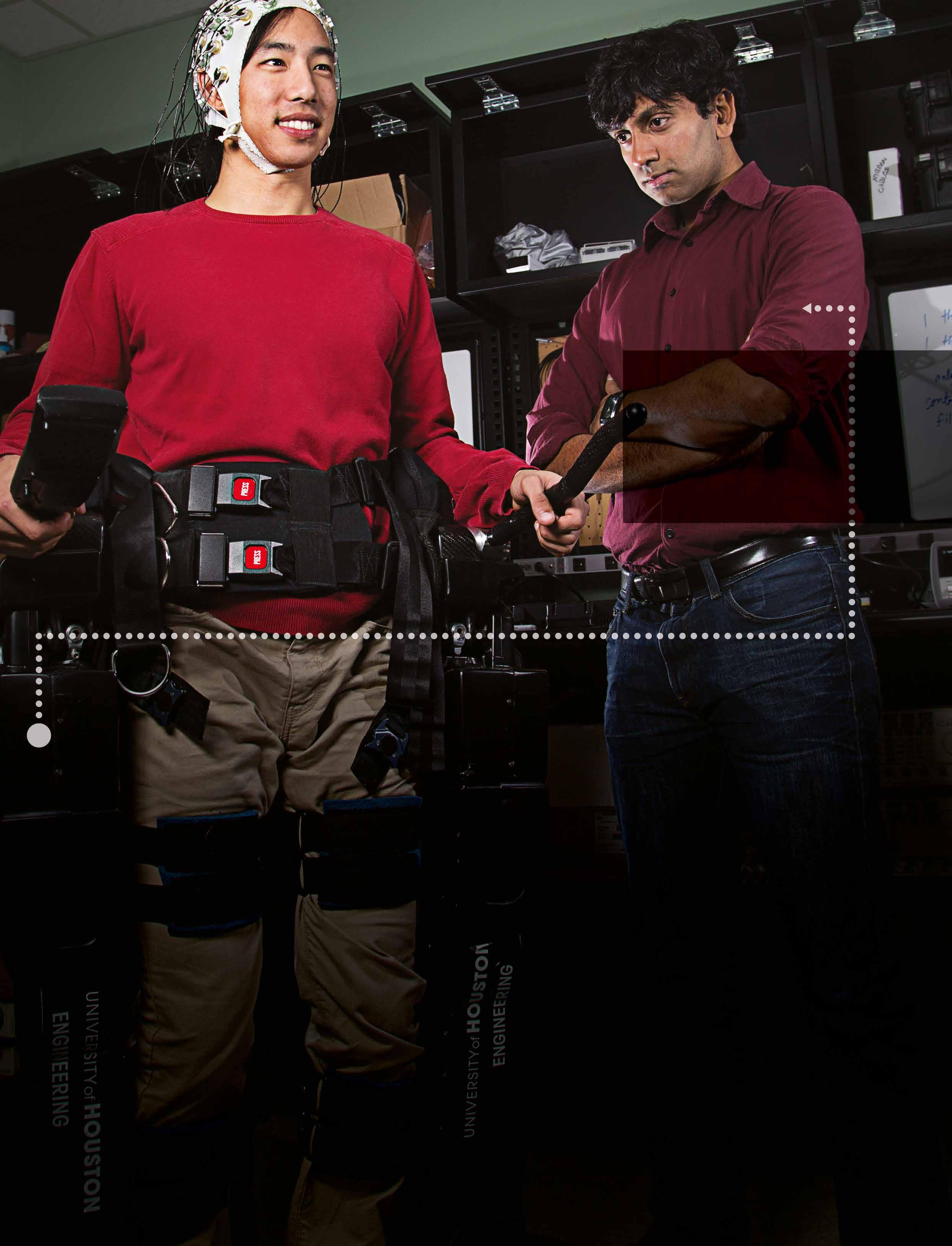
8 minute read
ROSALIND
Getting to the heart of cardiovascular diseases
Vast amounts of genomic data are available today, and analysing it can help researchers pinpoint the genetic factors involved in the development of disease. We spoke to Dr Nabila Bouatia-Naji about her research into the genetic causes of conditions associated with cardiovascular diseases, and its wider importance to diagnosis and treatment.
There is a relatively small degree of variability in genetic profile across the human population, and any two individuals have very similar DNA sequences in their genomes. However, there are variations, and analysing minor differences across the population could help researchers identify which are associated with cardiovascular diseases, a topic central to the ROSALIND project. “We look at the specific differences in the genomes of different individuals, and compare patients with certain cardiovascular diseases with people who don’t have these conditions. By comparing them we can then identify, in the genome, the important differences,” explains Dr Nabila Bouatia-Naji, the project’s Principal Investigator. Based at the French National Institute of Health and Medical Research (Inserm) in Paris, Dr BouatiaNaji is working to identify differences in the genome that are associated with certain types of cardiovascular disease. “It could be that because there is a little bit less of a protein, certain cells are more likely to be unstable, and then this will affect the structure of the arteries,” she outlines.
Cardiovascular diseases
The coronary arteries play an important role in the transport of oxygenated blood to the heart, so they need to function correctly. The function of the coronary arteries is underpinned by many different biological events and processes, and problems here can have serious consequences, even a myocardial infarction. “A myocardial infarction can be due to many different reasons, not just the accumulation of cholesterol. When we look at the genetic causes of cardiovascular diseases, we may find different genetic causes, many different events happening at the cellular level that in the long-term may leave individuals more prone to arterial disease,” says Dr Bouatia-Naji. The aim now is to build a deeper picture of the genetic factors associated with cardiovascular diseases such as fibromuscular dysplasia, and spontaneous coronary artery dissection, two conditions that affect blood vessels “We have data on around 3,000 patients with one or both of these diseases, as well as data on more than 6,000 individuals who don’t,” continues Dr Bouatia-Naji.
This provides solid foundations for researchers to investigate the underlying genetic factors behind the diseases, which affects the structure of arteries. One striking point is that the vast majority of patients affected are women, an issue Dr Bouatia-Naji is exploring in the project. “Maybe it’s because women’s hormone levels fluctuate every month. So, these repeated increases and decreases in hormone levels may affect the stability of the arteries,” she suggests. Researchers in the project are able to look at the genetic determinants of these fluctuating hormone levels, from which deeper insights into cardiovascular diseases can then be drawn. “In
one of our projects we’re studying the genetic determinants in the genome, that influence an individual’s levels of testosterone or oestrogen in order to identify if patients with naturally higher or lower levels of these hormones are more prone to these diseases” says Dr Bouatia-Naji. “The strength of a genetics-based approach is that genetic information doesn’t change over time, while hormone levels in women change almost from day-to-day during
an individual’s lifetime.”

The samples from both healthy controls and patients with specific cardiovascular diseases are sent to specific genomic centres, which house specialist machines to analyse DNA. The results are then sent back to Dr Bouatia-Naji and her colleagues for further investigation. “We use computational biology and statistical methods to analyse this data. We try to compare, for instance, all the differences that were categorised in our cases and in the controls. Then we apply statistical tests, to see if these differences are meaningful, and where they are localised in the genome,” she outlines. This approach has already yielded results; a variant of interest on the gene called PHACTR1 has been incriminated. “We found an allele, a version of this specific position in

Names of members of my team are from left to right: Delia Dupré, Nabila Bouatia-Naji, Adrien Georges, Mengyao YU, Romain Glandier, Sergiy Kyryachenko, Lu LIU, Dana Federici, and Takiy Berrandou.
Image courtesy of Pr. Pascal Motreff, CHU Clermont-Ferrand.


the genome, in greater frequency among the cases, compared to the controls. This is how we realised that this gene plays a role in the diseases, but we still ignore how it works at the cellular level,” continues Dr Bouatia-Naji.
This specific result has been found to hold clear relevance in terms of association with cardiovascular diseases studied by the team, now they are looking to identify more genetic variations in genes like PHACTR1. “We are studying how these variants affect the genes that are the target of these regulations. These genetic differences could affect the amount or the distribution of proteins involved in maintaining the solidity of the artery for instance,” outlines Dr Bouatia-Naji. “The strength and flexibility of the arteries are very important. Genetic factors may cause the loss of well balanced ability of the artery to be at the same time flexible and stiff enough to supply the heart.”
These types of structural problems in arteries can lead to a myocardial infarction, as blood circulation is blocked. In the case of the diseases studied in the ROSALIND project, there is often no prior warning or heightened awareness that an individual is at higher risk of suffering a myocardial infarction, in contrast to somebody who has high cholesterol levels for example and been advised to modify their lifestyle. “We know that if you have high cholesterol, you are at high risk of having a myocardial infarction,” says Dr Bouatia-Naji. People with fibromuscular dysplasia often have normal cholesterol levels however, and may not have any of the other symptoms commonly associated with cardiovascular disease, so Dr Bouatia-Naji is looking more at the genetic causes. “Our aim here is to understand the maintenance of certain arteries, like the coronary artery and the renal artery,” she continues. “We want to know what genes are important and involved in the development and maintenance of the flexibility and stiffness of these specific arteries.”

Diagnosis and treatment
The wider aim in this research is to help improve the diagnosis and treatment of these particular cardiovascular diseases. While it is difficult to anticipate when a myocardial infarction is going to occur, a better understanding of how diseases like fibromuscular dysplasia develop could open up the possibility of identifying people at risk of suffering repeat events. “If we can understand the genetic factors that may leave an individual more prone to repeat events, then maybe we can propose appropriate clinical management and try to help prevent them,” outlines Dr Bouatia-Naji. A more detailed understanding of fibromuscular dysplasia also holds relevance in terms of developing tailored treatments for cardiovascular diseases. “Currently there is a tendency to prescribe drugs to everybody, without taking into account an individual’s background,” says Dr Bouatia-Naji. “A person recovering from a myocardial infarction will be prescribed statins to reduce their cholesterol level.”
This may not be relevant in cases where the myocardial infarction was caused more by the structure of the arteries than cholesterol level, one of the issues that Dr Bouatia-Naji plans to explore further in future. A large amount of data has been generated over the course of the project, and Dr Bouatia-Naji says there is still work to do in terms of understanding how genetic background affects the development of cardiovascular disease. “We use a lot of publicly available data alongside the data that we’ve generated. Then we combine them and try to interpret them in the light of what we know about the diseases of interest to us and how they differ from other cardiovascular diseases,” she continues. One major area of interest is investigating why men and women are more prone to different forms of cardiovascular diseases, a topic explored in a recent paper. “Males are more prone to one kind of disease, while females are more prone to another, and this is reflected in the genetic variations too,” outlines Dr Bouatia-Naji.
ROSALIND Investigating fibROmuscular dysplasia and spontaneous coronary Artery dissection using genetic and functionaL genomics to decipher the origIN of two female specific cardiovascular Diseases Project Objectives
Cardiovascular disease (CVD) is under-diagnosed and under-investigated in women. The main aim in the project is to understand the genetic basis and the initial molecular regulation of genes involved in atypical cardiovascular diseases, specifically fibromuscular dysplasia (FMD) and spontaneous coronary artery dissection (SCAD), which mostly affect women. By using genomewide association in case control cohorts, researchers hope to decipher the genetic basis of FMD and SCAD.
Project Funding
Funded by the European Reserarch Council ERC-2016-STG, LS4 Max ERC Funding 1 500 000 €
Contact Details
Project Coordinator, Dr Nabila Bouatia-Naji, MSc, PhD Paris Cardiovascular research Centre (PARCC) Inserm - UMR970 Team 3 56 Rue Leblanc 75015 Paris FRANCE T: +33 1 53 98 79 95 E: nabila.bouatia-naji@inserm.fr W: parcc.inserm.fr W: nabilabouatianaji.fr : @n_bouatianaji : @parcc_inserm
Dr Bouatia-Naji
Dr Bouatia-Naji is a geneticist and an INSERM laboratory director at the Paris Cardiovascular research center (PARCC), Université de Paris, France. She managed a multidisciplinary team including statisticians, molecular biologists and clinicians who use genetics and functional genomics to understand vascular disease, with high prevalence in women, mainly fibromuscular dysplasia and SCAD. She is an active advocate for more leadership opportunities for women in health sciences, and generally in STEM.












